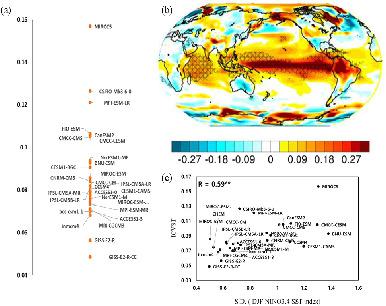当前位置:
X-MOL 学术
›
Q. J. R. Meteorol. Soc.
›
论文详情
Our official English website, www.x-mol.net, welcomes your
feedback! (Note: you will need to create a separate account there.)
Surface temperature variability in climate models with large and small internal climate variability
Quarterly Journal of the Royal Meteorological Society ( IF 3.0 ) Pub Date : 2021-06-15 , DOI: 10.1002/qj.4112 Sang‐Wook Yeh 1 , Seung‐Hwon Hyun 1, 2 , In‐Hong Park 1 , Xiao‐Tong Zheng 3
Quarterly Journal of the Royal Meteorological Society ( IF 3.0 ) Pub Date : 2021-06-15 , DOI: 10.1002/qj.4112 Sang‐Wook Yeh 1 , Seung‐Hwon Hyun 1, 2 , In‐Hong Park 1 , Xiao‐Tong Zheng 3
Affiliation

|
By analyzing large ensemble simulations using the Community Earth System Model (CESM_LE), the Max Planck Institute Earth System Model Grand Ensemble (MPI_GE), and Coupled Model Intercomparison Project phase 5 (CMIP5) climate models, we quantified internal climate variability (ICV) of surface temperature in each model based on the spread of simulated global mean surface temperature from the ensemble mean. Then, we examined the characteristics of simulated surface temperature variability in climate models with large and small ICV in the present climate and in a future climate. Both the CESM_LE and MPI_GE members with large ICVs tended to simulate larger surface temperature variability at low latitudes, including El Niño and Southern Oscillation (ENSO) variability, and larger cooling and warming trends of the global mean surface temperatures than those with small ICVs in the present climate. Similar characteristics were observed in CMIP5 climate models with large and small ICVs in the present climate. This implies that surface temperature variability including extreme climate events should be cautiously examined in climate models with large and small ICVs. On the other hand, the characteristics of surface temperature variability simulated in the CMIP5 climate models with large or small ICVs were similar from the present climate to future climate with magnitude of ICVs. This was in contrast to that simulated in the CESM_LE and MPI_GE, in which the magnitude of ICV changes between the present climate and the future climate. We inferred that these differences between CMIP5 climate models and large ensemble simulations could primarily be attributed to intermodel differences in the CMIP5 climate models, including model physics and parameterizations.
中文翻译:

具有大小内部气候变率的气候模型中的地表温度变率
通过使用社区地球系统模型 (CESM_LE)、马克斯普朗克研究所地球系统模型大集合 (MPI_GE) 和耦合模型比对项目第 5 阶段 (CMIP5) 气候模型分析大型集合模拟,我们量化了每个模型中的表面温度基于模拟的全球平均表面温度从集合平均值的分布。然后,我们研究了在当前气候和未来气候下具有大小 ICV 的气候模型中模拟的地表温度变化的特征。具有大 ICV 的 CESM_LE 和 MPI_GE 成员都倾向于模拟低纬度较大的表面温度变化,包括厄尔尼诺和南方涛动 (ENSO) 变化,全球平均地表温度的降温和升温趋势比当前气候下小 ICV 的要大。在当前气候下具有大型和小型 ICV 的 CMIP5 气候模型中观察到类似的特征。这意味着在具有大型和小型 ICV 的气候模型中应谨慎检查包括极端气候事件在内的地表温度变化。另一方面,CMIP5气候模式模拟的大、小ICV的地表温度变化特征,从当前气候到未来气候,ICV的大小都相似。这与在 CESM_LE 和 MPI_GE 中模拟的情况形成对比,其中 ICV 的大小在当前气候和未来气候之间变化。
更新日期:2021-08-04
中文翻译:

具有大小内部气候变率的气候模型中的地表温度变率
通过使用社区地球系统模型 (CESM_LE)、马克斯普朗克研究所地球系统模型大集合 (MPI_GE) 和耦合模型比对项目第 5 阶段 (CMIP5) 气候模型分析大型集合模拟,我们量化了每个模型中的表面温度基于模拟的全球平均表面温度从集合平均值的分布。然后,我们研究了在当前气候和未来气候下具有大小 ICV 的气候模型中模拟的地表温度变化的特征。具有大 ICV 的 CESM_LE 和 MPI_GE 成员都倾向于模拟低纬度较大的表面温度变化,包括厄尔尼诺和南方涛动 (ENSO) 变化,全球平均地表温度的降温和升温趋势比当前气候下小 ICV 的要大。在当前气候下具有大型和小型 ICV 的 CMIP5 气候模型中观察到类似的特征。这意味着在具有大型和小型 ICV 的气候模型中应谨慎检查包括极端气候事件在内的地表温度变化。另一方面,CMIP5气候模式模拟的大、小ICV的地表温度变化特征,从当前气候到未来气候,ICV的大小都相似。这与在 CESM_LE 和 MPI_GE 中模拟的情况形成对比,其中 ICV 的大小在当前气候和未来气候之间变化。











































 京公网安备 11010802027423号
京公网安备 11010802027423号